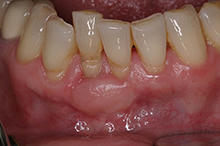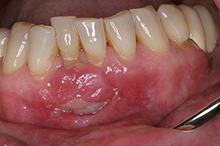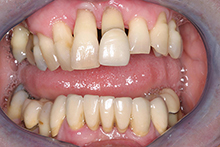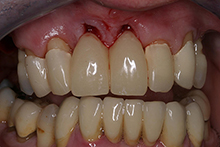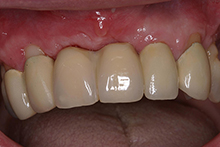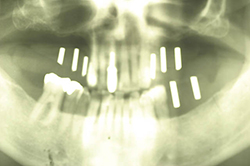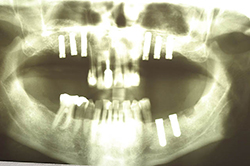We distinguish between two kinds of gum transplant, depending on whether we have to transplant the superficial layer or the deeper layer.
The superficial version is required in areas where there is a lack of fixed gum tissue attached to the bone. This fixed gum tissue protects the tooth and implant by acting like a tightly fitting rubber band to stop food residues and bacteria penetrating the gingival margin.
We remove the free mucous membrane transplant needed for this purpose from the palate and transplant it to the area required after surgically preparing a receiving area; the transplant is then sutured to this area and becomes attached to it within just a few days. During the healing period, the area of the palate from which the transplant tissue was removed is protected by a soft, flexible plastic plate.
We use the deeper gum layer, i.e. the connective tissue, if we want to increase the volume of gum tissue in just one area. The connective tissue is likewise taken from the palate and the site closed by suturing. The tissue removed is transplanted to a surgically prepared area, e.g. to create a bridge or to improve the function and appearance of the gum tissue before inserting an implant.
Bone transplants
When rebuilding the jaw with bone, we first consider the type of jaw defect to establish where the bone substance must be produced and how much.
Small pieces of bone (bone chips) mixed with bone substitution material If implants are to be inserted in the region of the upper molars, there may not be sufficient bone as this area is so close to the maxillary sinus. In such cases, the bone has to be built up at the base of the maxillary sinus. This is now a routine procedure in our practice. The bone is built up using a mixture of the patient's own bone, extracted while drilling the implant sites, and the bone substitute dot Bio-Oss®, which we mix with a concentrate made of the patient's own blood platelets (PRP/PRGF) to promote the long-term healing process. This procedure can usually be performed while the implant is being inserted, and turns into stable, robust bone within six to nine months.
X-rays before and after implantation with simultaneous build-up of bone substance in the maxillary sinuses.
Bone block grafting
If there is too much bone missing before implantation, a piece of solid bone must be transplanted. This can be removed from the area around and behind the lower wisdom teeth, transplanted to the place required and screwed in place using tiny microscrews made of titanium. The bone is then allowed to heal for six months before inserting the implants.


